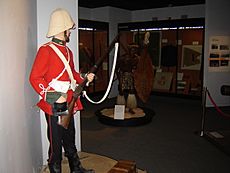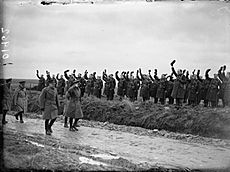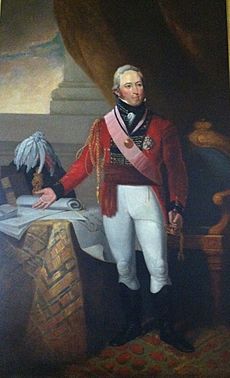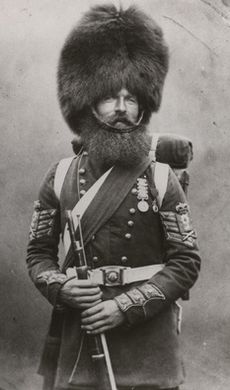List of wartime orders of battle for the British 1st Division (1809–1945) facts for kids
Quick facts for kids
|
|
|---|---|

A white triangle was used as the divisional insignia during the Second World War.
|
|
| Active | Raised and disbanded numerous times since 1809 |
| Country | |
| Branch | |
| Engagements | Napoleonic Wars Crimean War Anglo-Zulu War Second Boer War First World War Second World War |
Imagine a huge team of soldiers, all working together under one command. That's a military division! It's like a big puzzle made of smaller units, each with its own job. A division's size and equipment can change a lot, depending on the war or the army's plans.
The 1st Division was a famous infantry (foot soldier) division in the British Army. It was formed many times, starting way back in 1809. This division fought in some of the most important wars in history, including the Peninsular War, the Battle of Waterloo, the Crimean War, the Anglo-Zulu War, and the Second Boer War. Later, a permanent 1st Division was created in 1902, which then fought in both the First World War and the Second World War.
When the 1st Division was first formed in 1809, it had about 6,000 soldiers. They didn't have much heavy support like artillery (big guns). But by the Second World War, it had grown to over 18,000 soldiers, with 72 artillery pieces and many other support weapons. This shows how armies and their divisions changed over time!
Contents
Fighting in the Napoleonic Wars (1809–1815)
The Napoleonic Wars were a series of big conflicts in Europe. In 1809, Arthur Wellesley, the British commander in Spain and Portugal, created four divisions, including the 1st Division.
The division's first big fight was the Battle of Talavera in 1809, where it had 5,964 soldiers. It kept a similar size throughout the Peninsular War (the name for the Napoleonic Wars in Spain and Portugal). For example, at the Battle of Vittoria in 1813, it had 4,854 men. The division was made up of several brigades, including British Guards regiments and units from the King's German Legion.
After the fighting ended in 1814, the division was disbanded. But it was quickly reformed in 1815 when the war started again. It then fought in the famous Battle of Waterloo, where it had 4,061 soldiers. After the war, the division stayed in France as part of the British Army of Occupation until it was disbanded in December 1818.
How the Division Changed in the Napoleonic Wars
The 1st Division's makeup changed often during the Napoleonic Wars. Brigades (smaller groups of units) were often named after their commanders, which meant their names changed frequently.
- Talavera Campaign (July 1809): The division had brigades led by commanders like Campbell, Cameron, Langwerth, and Low. It included famous units like the Coldstream Guards, Scots Guards, and the 60th (Royal American) Regiment. It also had several battalions from the King's German Legion.
- Battle of Bussaco (September 1810): The division had four brigades. It still included the Guards and King's German Legion units, but also added regiments like the 42nd Regiment of Foot (Black Watch) and the 79th Regiment of Foot.
- 1810–1811 (including Torres Vedras and Fuentes de Oñoro): The division kept a similar structure, with Guards, other British regiments, and King's German Legion units.
- Battle of Salamanca (1812): The division's brigades continued to include Guards, other British regiments, and King's German Legion units.
- Vittoria Campaign (1813): The division's structure remained similar, with Guards and King's German Legion units.
- Battle of Nivelle (November 1813): The division had three main brigades, including the 1st and 3rd Battalions of the 1st Regiment of Foot Guards, Coldstream Guards, Scots Guards, and King's German Legion units. An extra brigade, Lord Aylmer's, also fought alongside it.
- Waterloo Campaign (1815): The division had two British brigades (First and Second British Brigades) made up of Guards regiments. It also had its own artillery, including Captain Sandham's British Foot Battery and Major Kuhlmann's Horse Battery from the King's German Legion.
The Crimean War (1854–1856)
In June 1854, a new 1st Division was formed for the Crimean War. This war was fought to support the Ottoman Empire against the Russian Empire. The division sailed to the Crimea and landed there in September.
It was involved in the long Siege of Sevastopol, and fought in battles like Alma and Inkerman. When fully staffed, the division had about 4,800 soldiers. However, at the Battle of Inkerman, it had only about 1,200 foot soldiers because of heavy fighting. The division stayed in the Crimea until the war ended in 1856.
How the Division Changed in the Crimean War
The 1st Division's structure changed slightly during the Crimean War:
- August–October 1854: It had the 1st Guards Brigade (with Grenadier, Coldstream, and Scots Fusilier Guards) and the 2nd Highland Brigade (with the 42nd (Highland) Regiment of Foot, 79th (The Queen's Own Cameron Highlanders) Regiment of Foot, and 93rd (Sutherland Highlanders) Regiment of Foot). It also had two field batteries for artillery support.
- November 1854–May 1855: The 2nd Highland Brigade was no longer part of the division, but the 97th (The Earl of Ulster's) Regiment of Foot joined the 1st Guards Brigade by January 1855. The artillery remained the same.
- June 1855: The 2nd Highland Brigade rejoined the division.
- August 1855–End of War: The division had the 1st Guards Brigade and a new 2nd Brigade, which included regiments like the 9th Regiment of Foot and 13th Regiment of Foot. It also had a field battery for artillery.
The Anglo-Zulu War (1879)

The Anglo-Zulu War started in January 1879. After some tough battles, like Isandlwana and Rorke's Drift, more British soldiers were sent to Natal (in South Africa) for a new attack. This led to the creation of No. 1 Division.
This division was quite large, with over 9,000 soldiers. It included about 6,500 British regular and colonial troops, plus 2,700 African soldiers. The division didn't see much direct fighting. Instead, it was mostly involved in building and engineering work. When the war ended in July, the division was broken up.
How the Division Was Organized in the Anglo-Zulu War
No. 1 Division had two main brigades:
- 1st Brigade: Included the 3rd Regiment of Foot, 88th Regiment of Foot (Connaught Rangers), and 99th (Lanarkshire) Regiment of Foot.
- 2nd Brigade: Included the 57th (West Middlesex) Regiment of Foot, 3rd Battalion, King's Royal Rifle Corps, and 91st (Argyllshire Highlanders) Regiment of Foot.
It also had many "Divisional troops" that supported the main brigades. These included three batteries of the Royal Artillery (big guns), a Naval Brigade (sailors who fought on land), engineers, and local African units like the Natal Native Contingent and scouts.
The Second Boer War (1899–1902)
When the Second Boer War started in South Africa, a new 1st Division was quickly put together in England. When it was ready, it had 10,075 soldiers, 745 horses, and 26 guns. It was sent to South Africa to help lift the Siege of Kimberley. The division fought in several battles, with mixed results and many casualties.
In early 1900, the division mostly defended areas, but it also carried out raids to destroy farms and take livestock. From April to June, it fought against various Boer Commandos as it marched through the Orange Free State and Transvaal. In June 1900, the division was changed a lot to become a more mobile force. This was to fight the Boer's guerrilla warfare tactics (small, fast attacks). By the end of the year, it was disbanded as the army's plans changed further.
How the Division Changed in the Second Boer War
The 1st Division's size and structure changed significantly during the war:
- On Mobilisation (1899): It had two infantry brigades (1st and 2nd). The 1st Infantry Brigade was made up of Guards regiments like the Grenadier, Coldstream, and Scots Guards. The 2nd Infantry Brigade included regiments like the Royal West Surrey and Devonshire Regiments. It also had artillery, engineers, and a cavalry squadron.
- Belmont to Magersfontein (November–December 1899): The division now had the 1st (Guards) Brigade and the 9th Infantry Brigade. For the Battle of Magersfontein, the 3rd (Highland) Brigade joined, bringing regiments like the Royal Highlanders (Black Watch) and Argyll and Sutherland Highlanders. More cavalry (like the 9th Lancers) and artillery batteries were also added, making it much larger.
- Based out of Kimberley (late February–May 1900): The division was reorganized with the 9th Brigade and 20th Brigade. It also included an Imperial Yeomanry brigade (volunteer cavalry) and more artillery.
- June 1900 onwards (Methuen's Column): The division was made much smaller and more mobile to fight guerrilla tactics. It had about 1,200 mounted troops, 2,400 foot soldiers, 12 field guns, and 11 machine guns. It included regiments like the Northumberland Fusiliers and Northamptonshire Regiment, along with Imperial Yeomanry and artillery.
The First World War (1914–1918)
The First World War began in July 1914. When Germany invaded Belgium in August, the United Kingdom joined the war. The 1st Division quickly went to France as part of the British Expeditionary Force and fought on the Western Front for the entire war.
The division's planned strength (called "war establishment") changed a lot during the war:
- 1914: 18,179 soldiers, 5,594 horses, 18 motor vehicles, 76 artillery pieces, and 24 machine guns.
- 1915: Similar number of men and horses, but fewer artillery pieces (48) and more motor vehicles (54).
- 1916: Increased to 19,372 men, 5,145 horses, 61 motor vehicles, 64 artillery pieces, 40 trench mortars, and 200 machine guns.
- 1917: Decreased to 18,825 men, 4,342 horses, 57 motor vehicles, and 48 artillery pieces. Machine guns increased to 264.
- 1918: Due to many casualties, the number of infantry battalions in a division was cut from twelve to nine. This made the division 16,035 men, 3,838 horses, 79 motor vehicles, 48 artillery pieces, 36 trench mortars, and 400 machine guns.
How the Division Was Organized in the First World War
The 1st Division had three main infantry brigades, plus many supporting units:
- 1st (Guards) Brigade (later 1st Brigade): Included Guards regiments like the Coldstream Guards and Scots Guards (until 1915), then other regiments like the Black Watch and Queen's Own Cameron Highlanders. It also gained a Trench Mortar Battery and a Machine Gun Company later in the war.
- 2nd Brigade: Included regiments like the Royal Sussex Regiment, Loyal Regiment (North Lancashire), and Northamptonshire Regiment. It also gained a Trench Mortar Battery and a Machine Gun Company.
- 3rd Brigade: Included regiments like the South Wales Borderers, Gloucestershire Regiment, and Welch Regiment. It also gained a Trench Mortar Battery and a Machine Gun Company.
The division also had many other important units:
- Divisional Mounted Troops: Cavalry squadrons and a Cyclist Company for scouting.
- Divisional Artillery: Several brigades of the Royal Field Artillery with different types of guns, including howitzers and later trench mortars.
- Divisional Engineers: Field companies for building and repairing, and a Signal Company for communications.
- Divisional Pioneers: A battalion (like the Welsh Regiment) that helped with construction and labor.
- Divisional Machine Guns: Companies that provided heavy machine gun support.
- Medical Services: Field Ambulances for treating wounded soldiers.
- Veterinary Services: For caring for the division's horses.
- Divisional Services: Companies of the Army Service Corps that handled supplies and transport.
The Second World War (1939–1945)

In 1939, when Germany invaded Poland, the United Kingdom declared war, starting the Second World War. The 1st Infantry Division fought in France in 1940. After the British Army's defeat there, the division returned to the UK to defend it.
Between June and November 1942, it was changed into a "mixed division," meaning one infantry brigade was replaced by a brigade of tanks. Then, it went back to being an infantry division and fought in the Tunisian campaign in 1943. It also captured the island of Pantelleria and then fought in the Italian campaign until January 1945. After that, it moved to Palestine and stayed there until the war ended.
How the Division Changed in the Second World War
The 1st Infantry Division's structure and strength changed several times during the Second World War:
- September 1939–May 1942:
* It had three infantry brigades: 1st Infantry Brigade (Guards), 2nd Infantry Brigade, and 3rd Infantry Brigade. These included regiments like the Grenadier Guards, Coldstream Guards, Hampshire Regiment, Loyal Regiment, Gordon Highlanders, Duke of Wellington's Regiment, and Sherwood Foresters. * Later, the 210th Infantry Brigade (renamed 38th (Irish) Infantry Brigade) joined, with units like the London Irish Rifles. * The division had various artillery regiments (Field, Anti-Tank, Light Anti-Aircraft), engineers, signals, and reconnaissance units (like the 13th/18th Royal Hussars and 1st Reconnaissance Battalion). It also gained a machine gun battalion (4th Battalion, Cheshire Regiment). * The division's planned strength grew from 13,863 men in 1939 to 17,298 men in 1941, with more vehicles, guns, and machine guns.
- Mixed Division (June–November 1942):
* It had two infantry brigades (2nd and 3rd) and a tank brigade (34th Tank Brigade, later 25th Tank Brigade). Tank units included the North Irish Horse and 147th Regiment Royal Armoured Corps. * The supporting units (artillery, engineers, signals, reconnaissance) remained similar.
- December 1942–End of War:
* It returned to being an infantry division with the 2nd and 3rd Infantry Brigades. * The 24th Infantry Brigade (Guards) joined, with Scots Guards, Irish Guards, and Grenadier Guards. * Later, the 18th Infantry Brigade and then the 66th Infantry Brigade joined, with regiments like the King's Own Yorkshire Light Infantry, Buffs, Royal Scots, and Lancashire Fusiliers. * The division's planned strength in 1944 was 18,347 men, with even more vehicles, anti-tank weapons, mortars, and machine guns. * Its supporting units continued to include various artillery regiments (Field, Anti-Tank, Light Anti-Aircraft), engineers (including a Bridging Platoon), signals, and reconnaissance units (now part of the Royal Armoured Corps). The Middlesex Regiment served as a support and then machine gun battalion.
See also
- NORTHAG wartime structure in 1989
- Order of battle of the Gulf War ground campaign
- Operation Granby order of battle
- Operation Telic order of battle




